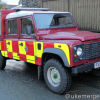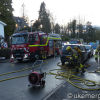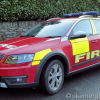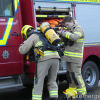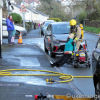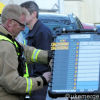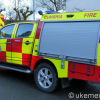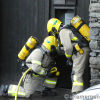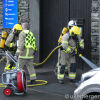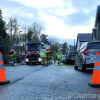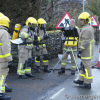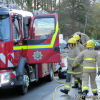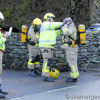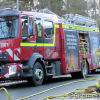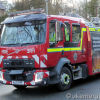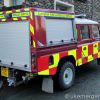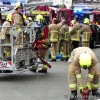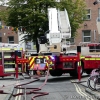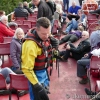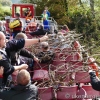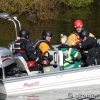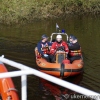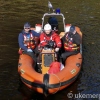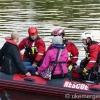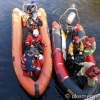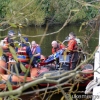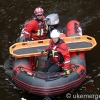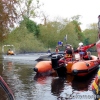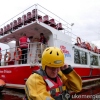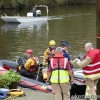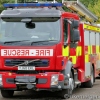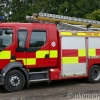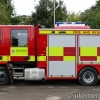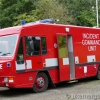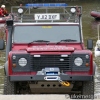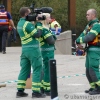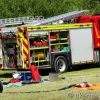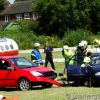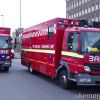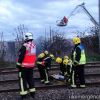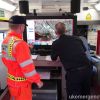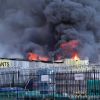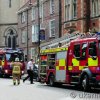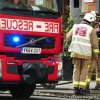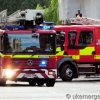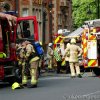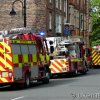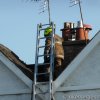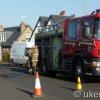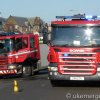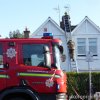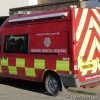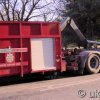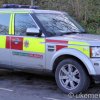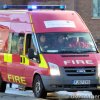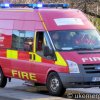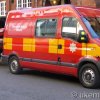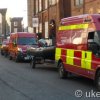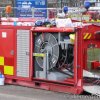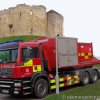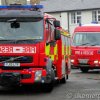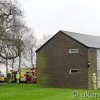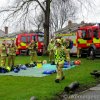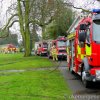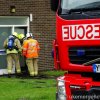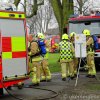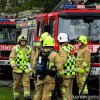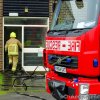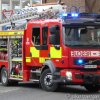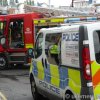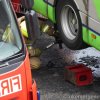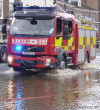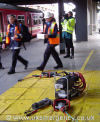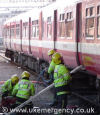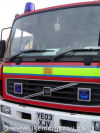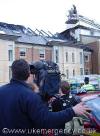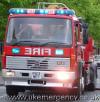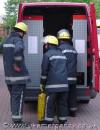Mass Decontamination (2013)
Here we see how the fire service deals with a major decontamination scenario at a college. The exercise starts with a parcel being delivered to the college which when opened releases an unidentified dust cloud into a room of staff and students. People in the room then begin to feel unwell so call the emergency services.

YJ09 EXN Police are first on the scene at the otherwise quiet college grounds.

YJ58 PZT Firefighters discuss the options at the early stages of this major incident.

Specially trained firefighters don protective suits that reduce the chances of them coming into contact with the mystery substance.

Firefighter enter the college and look for the suspicious substance.

The building is checked and the source of the contamination hunted.

A fire appliance in left unattended as firefighters prepare equipment.

One simple but effective method for creating a foot washing pool is shown here. Three ladders are joined and covered with a tarpaulin.

L796 GVN Reinforcements arrive and a sector commander instructs the crews where to park and what to do in the first instance.

N612 WYP A Salvage and Environmental Control Unit, operated in conjunction with the Environment Agency, has arrived.

The rear view.

One senior firefighter wears a checked tabard to signify his control status. He records all firefighters entering and leaving the building along with their remaining air supply.

YJ57 BZE More units arrive at the scene to assist in the rescue and decontamination effort.

YJ58 DJK, MX56 NHC A fire appliance from a neighbouring county follows a DIM vehicle (detection, identification and monitoring).

A fire crew approach the DIM unit. Notice the lack of markings on the vehicle as it may cause alarm to the general public.

Specially trained firefighters emerge from the DIM unit and liase with crews that are already up to speed with where the incident is.

The roadside near the incident fills up with supporting fire vehicles.

N765 YEF The county’s incident command unit arrives on scene. This 1996 Volvo conversion was repainted from white to red in 2012.

The rear view of the control unit.
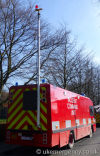
The command unit with the antenna erected. A red flashing light is used to help find the vehicle quickly at the scene.

A closer look at the red rotating beacon. A fire service control unit is a rare example of when a red light is permitted to be shown at the front of a vehicle.

Police officers look on as construction of decontamination tents takes place.

This large pop-up tent is used for potentially contaminated people to shower as they exit the danger zone.

Some of the detection equipment is unloaded and firefighters are briefed.

YJ58 PZU Appliances from far and wide are in attendance on the crisp winter morning.

Suited firefighters search the ground for any traces of hazardous substances outside the college building.

The suits and cumbersome to wear but provide essential protection. Inside, the firefighters are wearing all of their normal fireproof clothing and full breathing apparatus. They can pull their arm up the sleeve and wipe the visor if required. Communication is mainly by arm signs and radio as it is difficult to speak and hear through the kit.

An overview of the coordinated bustle immediately outside of the cordoned-off area.

Two firefighters carry specialist detecting equipment into the building. There is some confusion as to exactly where they are going. They are relying on verbal directions as no map of the large building is available.

The incident commander talks with firefighters at the outer cordon.

This is the funnel that greets anyone leaving the danger area. Firefighters use the near tent for showering (still wearing the protective suits) and the second tent is for the public to use under instruction.

A firefighter entering the smaller showering tent.

Members of the public are escorted from the building. They are wearing orange ponchos and face masks supplied by the fire service.

They carry their clothing in clear bags. These would normally be seized and carefully destroyed due to the contamination risk.

The public caught up in the incident are given instructions and enter the multi-stage showering process.

A little comfort is offered to showering people: a diesel heater warms the water before it is fed to the tent’s in-built water jets.

The first of the casualties emerges from the tent at the ‘safe’ end. He has changed into a boiler suit provided by the fire service. You can see the tent is divided in two down the middle for males and females.

A relieved casualty is greeted by a smiling firefighter and escorted away to safety.

More decontaminated people emerge and are passed over to waiting firefighters on a one-to-one basis.

A teenager is led to safety, wearing two layers of complimentary temporary clothing.

N928 YAU The British Red Cross’ fire and emergency support camper van is in attendance. The team usually look after people who have been displaced from their homes until they can find temporary accommodation. Here they look after the people who have just been declared safe to leave the scene after being decontaminated. They offer somewhere dry to sit and a comforting cup of tea.

